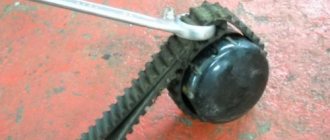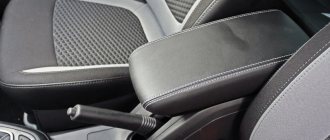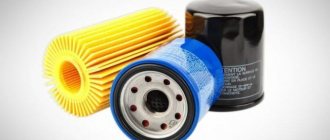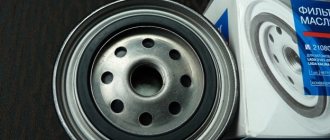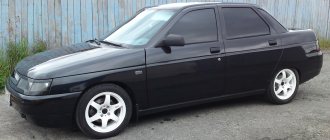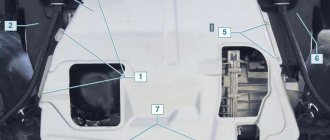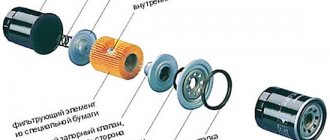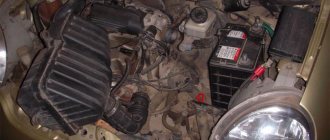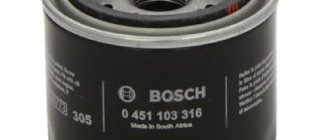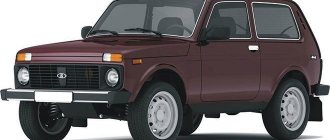| № | Name | Rating | Nomination |
| 1 | MANN FILTER W 914/2 | 4.65 | The most popular |
| 2 | MAHLE OC384 | 4.55 | High quality build |
| 3 | LADA 21080-1012005-08 | 4.50 | Reliability and quality |
| 4 | FILTRON OP 520/1 | 4.45 | The most affordable |
| 5 | GOODYEAR GY1102 | 4.30 | The best balance of price and quality |
Moving and rubbing engine parts wear out greatly at high temperatures. Motor oil cools and cleanses them of waste products. In turn, the oil filter removes metal shavings, contaminants, waste products and impurities from the engine lubricant. This allows you to maintain the quality of motor lubrication at the proper level.
The oil filter, according to the manufacturer's regulations, needs to be changed every 14-15 thousand km and after break-in (3000 km). But caring drivers do this already at 10-12 thousand due to the difficult urban operating conditions of the car. Replace the oil filter in parallel with the oil.
They differ in seating dimensions, quantity and quality of filter material (the size of the filter depends on this) and bypass valve pressure. For Lada Vesta 1.8 and 1.6 (cross, sedan), filters with an internal diameter of the seat ring of 62 mm, an external diameter of the ring of 71 mm and a thread of ¾-16 UNF are suitable.
Drivers of the Lada Vesta (cross, sedan) most often choose the MAHLE, MANN brands or the LADA branded filter. But there are also other models with good filtering capabilities.
Functions and principle of operation of the device
The oil filter is an important component of the car's lubrication system. This system supplies lubricant under pressure or by gravity to the contacting parts of the motor. The lubricant forms a thin film on the surface of the parts, reducing the friction force.
When the engine is running, oil passes through all its main components and mechanisms. It flushes contaminants into the oil pan or into a separate oil tank in dry sump vehicles. To reuse such a lubricant, it is important to clean it to prevent impurities from re-entering the system.
The oil filter works very simply. After the engine starts, the oil pump supplies oil to the filter element. There it passes through the pores, is cleaned of impurities and enters the discharge line.
Technical characteristics of the VAZ 21129 1.6 16kl engine
| Type | in-line |
| Number of cylinders | 4 |
| Number of valves | 16 |
| Exact volume | 1596 cm³ |
| Cylinder diameter | 82 mm |
| Piston stroke | 75.6 mm |
| Supply system | injector |
| Power | 106 hp |
| Torque | 148 Nm |
| Compression ratio | 10.5 — 11 |
| Fuel type | AI-92 |
| Environmental standards | EURO 5 |
Types of oil filters
Oil filtration systems are available in full-flow, partial-flow and combined types.
In a full-flow system, all the oil passes through the purifier. The cleaning speed is high, but if the filter element is clogged, the bypass valve directs the lubricant into the system without cleaning. This is exactly the oil filter found on the Lada Vesta.
In a partial flow system, only a portion of the lubricants passes through the filter element. Filtration is higher quality, but also slower.
Oil filter "Mann" for Lada Vesta. Photo source: https://stars-auto.com/catalog/i_14725
In a combined system, two filters are installed: full-flow and partial-flow. This system provides good oil cleaning and engine protection.
The Vesta full-flow oil filter consists of the following parts:
- Metal housing with several inlet holes and one threaded outlet.
- Cardboard filter element. To increase the filtration area, it is made corrugated or rolled into a roll.
- The bypass valve redirects the oil past the filter element. This can happen in winter when the oil is too viscous, or when it is very dirty and cannot be cleaned. In this case, contaminated lubricant reaches the parts, but this is better than working dry.
- The anti-drain valve prevents the oil from draining completely from the filter. This is necessary to supply lubricant to the line immediately after starting the engine.
- The sealing gasket ensures the tightness of the system.
There are also non-removable and serviceable oil purifiers. If the former are completely changed during maintenance, then only the filter cartridge is replaced for the latter.
Top 4. FILTRON OP 520/1
Rating (2021): 4.45
5 reviews from resources taken into account: Ozone
The most affordable Inexpensive filter made in Poland, which copes with its responsibilities.
- Characteristics
Average price: 197 rub.
- Country: Poland
- Height, mm: 70
- Weight, g: 421
The most budget model in our rating comes from Poland. The filter paper is thinner than in more famous filters. However, the area of the curtain, taking into account the glued edges, is 1200 square meters. cm is a sufficient indicator. Car owners are satisfied with the quality of filtration and assembly of the model, especially in combination with its affordable price. But not everyone is completely happy with the design of this model. Some drivers believe that during operation the filter element may become deformed.
Advantages and disadvantages
- Price
- Cleaning level
- Filtration area
- Do you have questions about the design of the filter element?
Which filter is better
The factory filter is of poor quality. It does not hold pressure well, depressurization and oil leakage often occur. Therefore, drivers are looking for a high-quality domestic or imported replacement.
The Mann W914/2 oil purifier, which is often installed on Vesta, has good quality and an affordable price.
The FRAMPH5822 from Sogefi Aftermarket features an accordion-style cleaning element for improved cleaning and increased throughput.
NF-1005 is produced in Russia and does not have any particular advantages or disadvantages.
Cooling system
The motor is equipped with a forced-type liquid cooling system. Cooling of the liquid is carried out in the radiator. The movement of coolant in the radiator and cooling jacket is carried out using a water pump. It is belt driven from the crankshaft of the power unit.
For quick warm-up in the cold season, a thermostat is included in the cooling system. At low coolant temperatures, the thermostat closes a large circulation circle. This allows for rapid heating of the coolant. Once the required temperature is reached, the thermostat opens a large circle.
IMPORTANT: The manufacturer has equipped the power plant with cooling of the working mixture. This design allows you to increase power and reduce fuel consumption.
Mann filter for Vesta
Mann filters have earned the trust of drivers for their quality. The German manufacturer produces a wide range of components for VAZ and Lada. But popularity has a downside. These parts are often counterfeited.
If you decide to purchase a Mann oil filter for Vesta, you need to be very careful not to ruin the engine with a low-quality fake. Buy spare parts only from trusted sellers. Before installation, carefully inspect your purchase, check the article number and model.
Tuning the Largus engine and other models with engine 21129
Modernization of power plants makes it possible to achieve higher technical characteristics. Improving engine performance is carried out in specialized workshops that have the appropriate equipment. For this purpose, specialists:
- The sleeves are bored to a diameter of 88 mm. This enlarges the combustion chamber;
- Lightweight pistons are installed;
- Smooth out irregularities in the intake and exhaust channels;
- Modernize the gas distribution mechanism;
- Flashing the electronic control unit.
IMPORTANT: The firmware of the electronic control unit is performed by highly qualified specialists. Violation of this rule can lead to complete failure of the product and costly repairs.
From the above it follows that the 21129 engine installed on the Lada Largus and other models is distinguished by its reliability and power. The manufacturer equipped the power plant with new attachments. By performing tuning, they improve the technical characteristics of the engine.
Filter life
The service life of an oil cleaner greatly depends on the operating conditions of the vehicle. Accelerated clogging of the filter element is greatly influenced by:
- climatic conditions and weather;
- dust and gas levels;
- quality of fuel and lubricants;
- condition of piston rings, oil valve caps and other engine parts.
When the piston rings are severely worn, gases from the cylinder break into the crankcase and change the composition of the oil. The result is substances that accelerate filter clogging.
If the valve stem seals are worn out, the oil enters the cylinder and burns there. The engine's consumption of lubricants increases, and substances are formed that contaminate the filter element.
The service life is greatly influenced by the quality of the cleaner itself. It is better to buy original spare parts. They are a little more expensive, but this is compensated by longer service life and reliability.
When to change
In accordance with the manufacturer's regulations, scheduled replacement is every 14,000 km, not including the first maintenance at around 3,000 km.
The box describes the models for which the part is suitable.
In practice, few owners adhere to the specified interval. Reasons for this:
- climatic conditions;
- increased dustiness;
- gas pollution;
- low quality of fuel, motor fluid, and the cleaner itself.
The average interval is 10 – 12 thousand km. The recommendation is for informational purposes only and is not a mandatory norm. If you love your car, you will still listen to the opinion of professionals.
Signs that replacement is needed
- an indicator on the dashboard indicates a malfunction in the engine;
- a mechanical sensor, if present, shows pressure below normal;
- The metal body of the purifier is damaged or deformed. Depressurization or fluid leakage has occurred;
- the scheduled replacement date has arrived;
- individual decision of the car owner about replacement.
Replacement procedure
Changing the oil and oil filter of Lada Vesta is a simple operation. If you wish, you can do it yourself, spending 15 minutes.
Required Tools
To replace the filter element, it must first be removed. This can be quite difficult. Due to the high engine temperature, the gasket sometimes sticks.
To unscrew the oil filter on a Vesta, it is most correct to use special spanners and sockets. If they are unavailable, you can use belt or chain pullers, which can be successfully replaced with a rope or belt with a lever. As a last resort, use a screwdriver and a hammer. You need to pierce the housing with a screwdriver closer to the top, and then use it as a lever.
Typically, replacing a filter coincides with changing engine oil, so you need to immediately prepare the required amount and a container for draining the used oil.
Gloves to protect your hands and rags to clean engine parts from oil residues and dirt will not be superfluous.
How to remove the old filter
To remove the Lada Vesta 1.6 oil filter, you need to do the following:
- install Vesta on an inspection hole, overpass or lift and secure it;
- warm up the engine and turn off;
- unscrew 13 screws and remove the metal engine protection;
- unscrew the drain plug and drain the old oil into a container, screw the plug.
Replacing the oil filter. Photo source: https://www.zr.ru/content/articles/853113-lada-vesta-menyaem-maslo-v-dvigatele-i-maslyanyj-filtr/
All that remains is to unscrew the filter and wipe the seat from oil and dirt.
How to install a new one
Before installing a new filter element, pour 100-150 g of clean oil into it, and then screw it into place without excessive force.
After this, reinstall the engine protection and fill the crankcase with new oil.
Recommendations for selection
Purchase consumables exclusively for the brand of your car. Use the services of official sales points, representative offices, dealer centers.
Check integrity, tightness, absence of defects and damage. The deeper the warehouses, the better the cleaning. The base of the cleaner must be metal. Various analogues and substitutes are unacceptable.
Carefully check the catalog numbers, date, and batch number on the packaging.
Conclusion
Individual standards for oil, filter, and other consumables have been developed for each technical product. The purchase of original components guarantees long-term and trouble-free operation of the machine. Saving on maintenance entails negative consequences, including major repairs.
The process of replacing the oil filter is simple. If you have tools and consumables, prevention will take no more than 15 minutes. You should contact the service center only in case of emergency or major breakdown.
Maintenance
Engine 21129 must be serviced in the following order to ensure a service life of at least 200 thousand km:
- after 10–15 thousand kilometers, it is necessary to take care of replacing the engine lubricant and filter;
- every 20 thousand it is necessary to inspect the cathode collector, spark plugs, alternator belt, battery and crankcase ventilation;
- after 40 - 45 thousand, the coolant and elements of the system of the same name, air and fuel filters, and the tank cap become unusable;
- after passing 90 - 100 thousand, you should check the integrity of the timing belt of the drive; if it breaks, the piston will crush the valve rod;
- According to the resource declared by the manufacturer, the belt is replaced after rolling 180 - 200 thousand km.
Bench tests of selected engines 21129 show that the real power at a speed of 5800 rpm is 5 hp. With. more.
Design Features
Initially, engine 21129 retained the design of the basic version 21127:
- “tall” gray cylinder block, transferred from 11183, the surfaces of the liners are processed by honing;
- Cylinder head from modification 21124;
- gas distribution mechanism with phased injection with hydraulic compensation of thermal valve clearance;
- lightweight piston group from Federal Mogul;
- V-belt drive of timing camshafts with rounded teeth from Gates with a service life of 200,000 km;
- crankshaft with long radius crank from internal combustion engine 11183;
- fuel rail with medium-performance injectors from Bosch or Siemens;
- individual spark plug ignition coils without a high-voltage wire bundle;
- increased diameter of the damper on the flywheel;
- catalytic converter built into the exhaust tract - catalytic collector.
Thus, the manufacturer does not provide for boosting the internal combustion engine in principle. Power and torque remained the same, oil consumption within 100 g/1000 km. The manual created by AvtoVAZ designers contains step-by-step operations, thanks to which major repairs can be done with your own hands.


